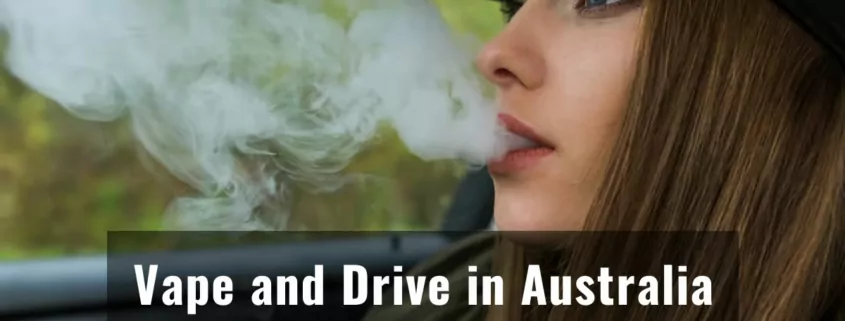Is It Illegal to Vape and Drive in Australia? A State-by-State Guide
Vaping’s growing popularity in Australia has outpaced vaping-specific driving laws. Most states and territories now regulate e-cigarette use in cars, but the rules vary across borders. We break down the complex patchwork of laws on vaping while behind the wheel down under.
What is Vaping?
Vaping means inhaling vapor from an e-cigarette or vape pen. These battery-powered devices heat liquids into an aerosol that users inhale. The “juice” usually contains nicotine, flavorings, and other chemicals. Vaping provides a nicotine hit without burning tobacco. Some vapers use these gadgets to quit smoking. But vaping still exposes lungs to potentially harmful ingredients.
Despite health uncertainties, vaping’s cooler image has made it trendy. Laws scramble to keep up as vaping booms in Australia. Driving rules now address vaping, but in inconsistent ways.
Vaping and Driving Laws in Australia by State
New South Wales (NSW)
No law specifically bans vaping while driving in NSW. But drivers risk fines under broader rules.
Rule 297 requires maintaining proper control of a vehicle. Vaping could be a distraction leading to a $481 fine and three demerit points. School zones raise fines to $603 and four demerit points.
Under the Public Health (Tobacco) Act 2008 (NSW), smoking or vaping in a vehicle with a passenger under 16 is illegal. Drivers and vaping passengers both face fines.
Victoria
Vaping while driving is not explicitly prohibited in Victoria. However, the Tobacco Act 1987 makes it illegal to smoke or vape in a motor vehicle if a person under 18 years is present. Violating this law can result in fines and court penalties, doing so risks a $384 fine and up to five penalty units ($961)..
Queensland
There is no specific law in Queensland that prohibits vaping while driving. However, it is illegal to smoke or use an e-cigarette when a child under 16 is present in the vehicle or if the vehicle is being used for business purposes with more than one person inside. Fines reach $3,000.
Western Australia
Vaping is permitted while driving in Western Australia, according to the Western Australia Police.
South Australia
Vaping while driving a motor vehicle is not an offense in South Australia. However, smoking, including e-cigarettes and vapes, is prohibited when children are present in the vehicle under the Tobacco and E-Cigarette Products Act 1997. Fines reach $750, with a $204 expiation fee.
Tasmania
Vaping is considered the same as smoking under the Public Health Act 1997 in Tasmania. Therefore, vaping is prohibited in vehicles used for employment purposes with another person present and in vehicles with children. Violations can result in significant fines. Fines up to $3,900 apply.
Australian Capital Territory (ACT)
Vaping while driving is generally legal in the ACT. However, it is illegal to vape if anyone in the vehicle is under 16 years old, according to the ACT Smoking in Cars with Children (Prohibition) Act 2011, which brings $150 individual and $750 corporate fines.
Vaping cannabis or dangerously distracting vaping also risk fines..
Northern Territory
Vaping and driving are not illegal in the Northern Territory if you are driving alone. However, it is an offense to use an e-cigarette in a car with a child under 16 years of age present. Fines reach $392.
Confused Yet?
Australia’s patchwork of vaping driving laws creates confusion. The lack of uniform national legislation leads to misunderstandings about what’s permitted where.
Most states allow solo vaping behind the wheel. But laws get hazy around child passengers and work vehicles. Queensland has the strictest laws, banning any vaping with multiple passengers. Tasmania broadly equates vaping to smoking. NSW and Victoria rely on distraction laws.
Penalties also vary wildly, ranging from $150 to $3,900 fines. Tasmania and Queensland come down hardest on vaping motorists.
Why So Complex?
States independently passed these laws as vaping grew prevalent. Lacking federal guidance, they created their own rules based on different rationales:
- Protecting children from vaping role models
- Discouraging teen vaping
- Reducing secondhand vapor exposure
- Promoting smoke-free environments
- Preventing distraction
But this piecemeal approach bewilders drivers crossing state lines. Confusion makes it easier for vapers to unintentionally break confusing laws.
A National Approach?
With more consistency, Australian drivers would better understand vaping driving rules. A single national policy would reduce complexity. But states design traffic laws to suit local conditions. Centralizing regulations may not serve diverse regions equally.
Ultimately vapers must research laws wherever they drive in Australia. To avoid fines, don’t vape with child passengers, follow workplace vaping bans, and prevent dangerous distraction. Remember laws differ across borders, so leave the vape at home when taking road trips.
In summary, vaping’s rise outpaced driving laws in Australia. The result is a perplexing patchwork of disparate rules. While states protect citizens, confused vapers can easily break vague laws. National consistency would aid comprehension, but local control has benefits too. For now, educate yourself on each state’s statutes before vaping and driving down under.
- Austria Plans to Ban Disposable E-Cigarettes - August 5, 2025
- Vaping vs. THC Drinks: Which Cannabis Option Is Right for You? - August 4, 2025
- Colombia’s New Vape Law: A Reality Check on Enforcement - August 4, 2025







